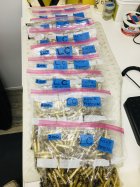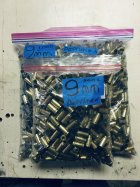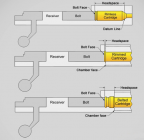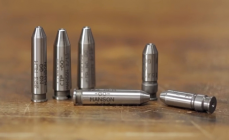Install the app
How to install the app on iOS
Follow along with the video below to see how to install our site as a web app on your home screen.
Note: This feature may not be available in some browsers.
You are using an out of date browser. It may not display this or other websites correctly.
You should upgrade or use an alternative browser.
You should upgrade or use an alternative browser.
Reloading questions and goofs from a novice
- Thread starter grumpygunner
- Start date
I only have one type of powder right now (Winchester StaBall 6.5) and I don't plan on getting anything else or reloading anything other than 6.5 Creedmoor for only 1 rifle right now.What you are going to measure is the distance from the base of the case to a point along the shoulder (datum line).
Headspace is the distance from the face of the CLOSED bolt to where that datum line touches the case inside the chamber. This would be changed (set) by the installer of the barrel. Some manufacturers have called their tool (erroneously) a headspace gauge.
Without trying to confuse matters (which the use of this name does) you may want to measure that distance on your BRASS.
Should you find a case that does not chamber OR after firing requires a HARD bolt lift to start extraction that would be an indicator that the shoulder of the brass may have to be 'bumped' back a couple of thousandths.
I'm trying hard to write this so it makes sense and I'm struggling.
Before you have reached this stage I would like to add one safety factor. Only the powder you are currently using should be on your bench. I mention this not out of disrespect but I do not know where you are in your reloading journey.
Your questions are well thought out and indicate to me this will a great hobby for you.
I've noticed the use of headspace being used to refer to exactly what you are doing but in fact headspace is internal.
You are doing fine and I hope I did not confuse the issue. There are many site members who could answer this clearer and in fewer words.
This entire thread has cleared up a bunch of questions I didn't quite get.
Thanks for the clarification.
I tend to go real deep into detail whenever I start something new, so all this is great info.
As others have mentioned, your steps should be in order so you can remember them.
And the most important rule of reloading is stop when you get distracted.
I process a lot of .223/5.56 and am anal about labeling every step of the processing. I also sort headstamps, keep the ones I like and sell the rest. I use blue painters tape, a sharpie and put brass in ziplock bags.


And the most important rule of reloading is stop when you get distracted.
I process a lot of .223/5.56 and am anal about labeling every step of the processing. I also sort headstamps, keep the ones I like and sell the rest. I use blue painters tape, a sharpie and put brass in ziplock bags.


TheCZKid
Silver $$ Contributor
I like reading this stuff too. Taking good notes and keeping records of what I did, the components I used, how many times a case was shot, primer used, seating depth, is a great way to know exactly what you did.
This year I found I needed to start keeping better documentation on my brass too. So I made up a spreadsheet with 32 of these per page, cut them out, and fill them out like a little form, to go with each batch of brass.
This helps me know if the brass is unshot, or how many times shot, sized, prepped in various ways, and if steps still need to be done before it's ready to load. It's made it a LOT easier to keep track of brass in little sub-lots. I need to add Annealed to the list...
Especially important while I'm testing for an accurate load. Lots of details to track, but better if you're organized and take good notes.

I also put my brass in plastic containers, and label the outsides with what's in them, so it's easy to track what the heck is in each container. Makes it a lot easier to find what I'm looking for, and the state of what's inside. I also like blue painters tape!

This year I found I needed to start keeping better documentation on my brass too. So I made up a spreadsheet with 32 of these per page, cut them out, and fill them out like a little form, to go with each batch of brass.
This helps me know if the brass is unshot, or how many times shot, sized, prepped in various ways, and if steps still need to be done before it's ready to load. It's made it a LOT easier to keep track of brass in little sub-lots. I need to add Annealed to the list...
Especially important while I'm testing for an accurate load. Lots of details to track, but better if you're organized and take good notes.
| Brass log |
| Caliber ____________ |
| Gun Used __________ |
| Brand _____________ |
| Times Shot _________ |
| Primer Pocket ______ |
| Flash Hole _________ |
| Chamfer Deburr _____ |
| Neck Turned _______ |
| Sized ____ Bush _____ |
| Die Used __________ |
| Trimmed _________ |
| Ready to Load ______ |

I also put my brass in plastic containers, and label the outsides with what's in them, so it's easy to track what the heck is in each container. Makes it a lot easier to find what I'm looking for, and the state of what's inside. I also like blue painters tape!

Last edited:
I probably wasn’t clear on the fired case measurement. I just use the Hornady comparator to measure cartridge base to ogive. That way I know what the measurement should be to bump back .092-.003.4.
I have tried to check for headspace before resizing, but the case will not go far enough into the gauge to reach the shoulder. Is this a product of my rifle' chamber dimensions?
9.
I was processing them in 10 rounds batches, I will do singles until I can do it blindfolded (which I won't really do).
I will stick to manufacturer published load data for the time being
Why are you crimping? Your bullet doesn't have a crimping groove. I doubt any BR shooter crimps. You may be distorting the shape of the bullet.Hi Guys,
I just started reloading and I've got a couples questions about things I think I messed up and things I'm not sure about.
Gear:
Lyman single stage C frame press
Lee Ultimate Dies in 6.5 Creedmoor
Lee Bench Perfect Primer
Lyman headspace gauge
Lee case trimmer/deburring tool
Frankford Arsenal de-priming tool
Load Data:
Caliber 6.5 Creedmoor
S&B or Sako once fired (all from my rifle) brass
Winchester StaBall 6.5 powder (40 grn)
Hornady ELD-M projectiles (140 grn)
CCI Large Rifle primers n. 200
My process so far:
De-prime
Rough clean of the primer pocket
Vibratory tumbling with treated Walnut media
Quick dusting to remove any dust from the Walnut media
Case lube (Hornady One-Shot)
Full length resize
Trim/deburr
Quick dusting to remove any metal shavings
Prime
Powder
Seat projectile
Light crimp
1.
I haven't gotten my process down yet, so I accidentally reloaded about 20 rounds without resizing the brass (S&B). I noticed the bullets were going in easier than the other batch of 20 I did previously (Sako brass), so I put it off to a difference in the brass. I only realized my mistake once I was done. I added a light factory crimp and the bullets are staying in and the vast majority of them do not wiggle. I can chamber and extract the other identical brass I haven't resized yet. I am not good enough of a shot (yet) to really be able to care about accuracy, but I would like to know if my assumption that they are safe to shoot is correct.
2.
After the above, I decided to resize a bunch of cases to avoid making the same mistake. I had previously resized others with no issues following tutorial on Youtube and got well headspaced cases according to my headspace gauge. However, this time I followed the instructions that came with the dies and didn't think to check the cases for headspace before doing 80 of them. Some of the cases (~40%) are either at or just below (<0.005) the minimum and the worst ones are 0.010 under the minimum, as per Lyman headspace gauge. Considering this is a bolt action rifle (Bergara B14 HMR) what tolerance should I have for cases that are under the minimum?
3.
How important is cleaning the inside or just the neck of used brass?
4.
Is it possible to set off primers with excessive, but constant, force when priming cases?
5.
Any other tips and tricks or comments about my process.
Thanks in advance.
Edited for spelling.
Last edited:
Still got it wrong. Why after 5 years I’m still an amateur. It’s base to shoulder not base to ogive. Duh4.
I have tried to check for headspace before resizing, but the case will not go far enough into the gauge to reach the shoulder. Is this a product of my rifle' chamber dimensions?
9.
I was processing them in 10 rounds batches, I will do singles until I can do it blindfolded (which I won't really do).
I will stick to manufacturer published load data for the time being
Sixgun
The Millbastard
Hi Guys,
I just started reloading and I've got a couples questions about things I think I messed up and things I'm not sure about.
Gear:
Lyman single stage C frame press
Lee Ultimate Dies in 6.5 Creedmoor
Lee Bench Perfect Primer
Lyman headspace gauge
Lee case trimmer/deburring tool
Frankford Arsenal de-priming tool
Load Data:
Caliber 6.5 Creedmoor
S&B or Sako once fired (all from my rifle) brass
Winchester StaBall 6.5 powder (40 grn)
Hornady ELD-M projectiles (140 grn)
CCI Large Rifle primers n. 200
My process so far:
De-prime
Rough clean of the primer pocket
Vibratory tumbling with treated Walnut media
Quick dusting to remove any dust from the Walnut media
Case lube (Hornady One-Shot)
Full length resize
Trim/deburr
Quick dusting to remove any metal shavings
Prime
Powder
Seat projectile
Light crimp
1.
I haven't gotten my process down yet, so I accidentally reloaded about 20 rounds without resizing the brass (S&B). I noticed the bullets were going in easier than the other batch of 20 I did previously (Sako brass), so I put it off to a difference in the brass. I only realized my mistake once I was done. I added a light factory crimp and the bullets are staying in and the vast majority of them do not wiggle. I can chamber and extract the other identical brass I haven't resized yet. I am not good enough of a shot (yet) to really be able to care about accuracy, but I would like to know if my assumption that they are safe to shoot is correct.
2.
After the above, I decided to resize a bunch of cases to avoid making the same mistake. I had previously resized others with no issues following tutorial on Youtube and got well headspaced cases according to my headspace gauge. However, this time I followed the instructions that came with the dies and didn't think to check the cases for headspace before doing 80 of them. Some of the cases (~40%) are either at or just below (<0.005) the minimum and the worst ones are 0.010 under the minimum, as per Lyman headspace gauge. Considering this is a bolt action rifle (Bergara B14 HMR) what tolerance should I have for cases that are under the minimum?
3.
How important is cleaning the inside or just the neck of used brass?
4.
Is it possible to set off primers with excessive, but constant, force when priming cases?
5.
Any other tips and tricks or comments about my process.
Thanks in advance.
Edited for spelling.
Your order of operations is good. The Lee Collet Die is VERY good..for concentricity at any budget. Try it for 26.99 at Brownells if you don't like it send it back. You just have to be careful not to push necks into the shoulder. The instructions will show you how to do it though. You really should anneal your necks every loading. It resets your neck tension and makes them uniform seating to seating. For a 6.5...8-9 seconds on a single propane Burnzamatic torch rotating them. I use a cordless drill with a keyless chuck tightened ever so lightly. There's no chuck marks or anything but it spins the brass in the flame..that's all you need.Hi Guys,
I just started reloading and I've got a couples questions about things I think I messed up and things I'm not sure about.
Gear:
Lyman single stage C frame press
Lee Ultimate Dies in 6.5 Creedmoor
Lee Bench Perfect Primer
Lyman headspace gauge
Lee case trimmer/deburring tool
Frankford Arsenal de-priming tool
Load Data:
Caliber 6.5 Creedmoor
S&B or Sako once fired (all from my rifle) brass
Winchester StaBall 6.5 powder (40 grn)
Hornady ELD-M projectiles (140 grn)
CCI Large Rifle primers n. 200
My process so far:
De-prime
Rough clean of the primer pocket
Vibratory tumbling with treated Walnut media
Quick dusting to remove any dust from the Walnut media
Case lube (Hornady One-Shot)
Full length resize
Trim/deburr
Quick dusting to remove any metal shavings
Prime
Powder
Seat projectile
Light crimp
1.
I haven't gotten my process down yet, so I accidentally reloaded about 20 rounds without resizing the brass (S&B). I noticed the bullets were going in easier than the other batch of 20 I did previously (Sako brass), so I put it off to a difference in the brass. I only realized my mistake once I was done. I added a light factory crimp and the bullets are staying in and the vast majority of them do not wiggle. I can chamber and extract the other identical brass I haven't resized yet. I am not good enough of a shot (yet) to really be able to care about accuracy, but I would like to know if my assumption that they are safe to shoot is correct.
2.
After the above, I decided to resize a bunch of cases to avoid making the same mistake. I had previously resized others with no issues following tutorial on Youtube and got well headspaced cases according to my headspace gauge. However, this time I followed the instructions that came with the dies and didn't think to check the cases for headspace before doing 80 of them. Some of the cases (~40%) are either at or just below (<0.005) the minimum and the worst ones are 0.010 under the minimum, as per Lyman headspace gauge. Considering this is a bolt action rifle (Bergara B14 HMR) what tolerance should I have for cases that are under the minimum?
3.
How important is cleaning the inside or just the neck of used brass?
4.
Is it possible to set off primers with excessive, but constant, force when priming cases?
5.
Any other tips and tricks or comments about my process.
Thanks in advance.
Edited for spelling.
Similar threads
- Replies
- 15
- Views
- 3,477
- Replies
- 14
- Views
- 3,960
Upgrades & Donations
This Forum's expenses are primarily paid by member contributions. You can upgrade your Forum membership in seconds. Gold and Silver members get unlimited FREE classifieds for one year. Gold members can upload custom avatars.

Click Upgrade Membership Button ABOVE to get Gold or Silver Status.
You can also donate any amount, large or small, with the button below. Include your Forum Name in the PayPal Notes field.
To DONATE by CHECK, or make a recurring donation, CLICK HERE to learn how.

Click Upgrade Membership Button ABOVE to get Gold or Silver Status.
You can also donate any amount, large or small, with the button below. Include your Forum Name in the PayPal Notes field.
To DONATE by CHECK, or make a recurring donation, CLICK HERE to learn how.











